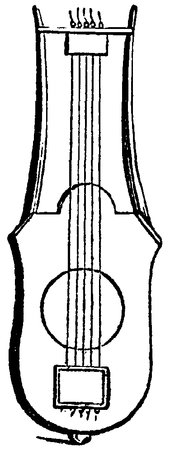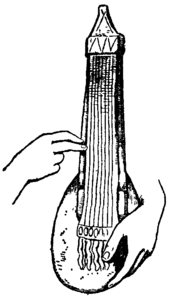Barbiton

The barbiton, or barbitos (Gr: βάρβιτον or βάρβιτος; Lat. barbitus), is an ancient stringed instrument known from Greek and Roman classics related to the lyre. The barbat or barbud, also sometimes called barbiton, is an unrelated lute-like instrument derived from Persia.
The Greek instrument was a bass version of the kithara, and belonged in the zither family, but in medieval times, the same name was used to refer to a different instrument that was a variety of lute.
Ancient descriptions
Theocritus (xvi. 45), the Sicilian poet, calls the barbitos an instrument of many strings, i.e. more than seven, which was by the Hellenes considered to be a perfect number, and matched the number of strings customary in the kithara.[1]
Anacreon[2] (a native of Teos in Asia Minor) sings that his barbitos only gives out erotic tones.[1] (A remark which could have been metaphorical, or could have been literal and referred to tuning in the Greek Phrygian mode – roughly C Major.)[3]
Pollux (Onomasticon iv. chap. 8, § 59) calls the instrument barbiton or barymite (from βάρυς, heavy and μίτος, a string), an instrument producing deep sounds. The strings were twice as long as those of the pectis and sounded an octave lower.[1]
Pindar (in Athen. xiv. p. 635), in the same line wherein he attributes the introduction of the instrument into Greece to Terpander, tells us one could magadize, i.e. play in two parts at an interval of an octave on the two instruments.[1]
Although in use in Asia Minor, Italy, Sicily, and Greece, it is evident that the barbiton never won for itself a place in the affections of ancient Greeks; it was regarded as a barbarian instrument affected by those only whose tastes in matters of art were unorthodox. It had fallen into disuse in the days of Aristotle,[4] but reappeared under the Romans.[1] Aristotle said that this string instrument was not for educational purposes but for pleasure only.
Often Sappho is also depicted playing the barbitos, which has longer strings and a lower pitch. It is closely associated with the poet Alcaeus and the island of Lesbos, the birthplace of Sappho, where it is called a barmos.[5] The music from this instrument was said to be the lyre for drinking parties and is considered an invention of Terpander. The word barbiton was frequently used for the kithara or lyre.[3]
Modern interpretation
In spite of the few meagre shreds of authentic information extant concerning this somewhat elusive instrument, it is possible nevertheless to identify the barbiton as it was known among the Greeks and Romans. From the Greek writers we know that it was an instrument having some feature or features in common with the lyre,[1] and kithara, which warranted classification with it.[1]
The later, unrelated instrument, is described by the Persians and Arabs as a kind of rebab or lute, or a chelys-lyre,[6] It was first introduced into Europe through Asia Minor by way of Greece, and centuries later into Spain by the Moors, amongst whom it was in the 14th century known as al-barbet.[7]
There is a stringed instrument, as yet unidentified by name, of which there are at least four different representations in sculpture,[8] which combines the characteristics of both lyre and rebab, having the vaulted back and gradual narrowing to form a neck which are typical of the rebab and the stringing of the lyre. In outline it resembles a large lute with a wide neck, and the seven strings of the lyre of the best period, or sometimes nine, following the decadent lyre. Most authors in reproducing these sculptures showing the barbiton represent the instrument as boat-shaped and without a neck, as, for instance, Carl Engel. This is because the part of the instrument where neck joins body is in deep shadow, so that the correct outline can hardly be distinguished, being almost hidden by hand on one side and drapery on the other.[1]
The Barbat

The barbat, or barbiton, pictured to the right is unlike the instrument depicted on Greek vase paintings.[1]
At some period not yet determined, which we can but conjecture, the barbat approximated to the form of the large lute. An instrument called barbiton was known in the early part of the 16th[9] and during the 17th century. It was a kind of theorbo or bass-lute, but with one neck only, bent back at right angles to form the head. Robert Fludd[10] gives a detailed description of it with an illustration:
Inter quas instrumenta non nulla barbito simillima effinxerunt cujus modi sunt illa quae vulgo appellantur theorba, quae sonos graviores reddunt chordasque nervosas habent.[1]
The people called it theorbo, but the scholar having identified it with the instrument of classic Greece and Rome called it barbiton. The barbiton had nine pairs of gut strings, each pair being in unison. Dictionaries of the 18th century support Fludd's use of the name barbiton. G. B. Doni[11] mentions the barbiton, defining it in his index as Barbitos seu major chelys italice tiorba, and deriving it from lyre and cithara in common with testudines, tiorbas and all tortoiseshell instruments. Claude Perrault,[12] writing in the 18th century, states that "les modernes appellent notre luth barbiton" (the moderns call our lute barbiton). Constantijn Huygens[13] declares that he learnt to play the barbiton in a few weeks, but took two years to learn the cittern.[1]
The barbat was a variety of rebab, a bass instrument, differing only in size and number of strings. This is quite in accordance with what we know of the nomenclature of musical instruments among Persians and Arabs, with whom a slight deviation in the construction of an instrument called for a new name.[14] The word barbud applied to the barbiton is said to be derived[15] from a famous musician living at the time of Chosroes II. (A.D. 590-628), who excelled in playing upon the instrument. From a later translation of part of the same authority into German[16] we obtain the following reference to Persian musical instruments: "Die Sänger stehen bei seinem Gastmahl; in ihrer Hand Barbiton(i.) und Leyer(ii.) und Laute(iii.) und Flöte(iv.) und Deff (Handpauke)." Mr Ellis, of the Oriental Department of the British Museum, has kindly supplied the original Persian names translated above, i.e. (i.) barbut, (ii.) chang, (iii.) rubāb, (iv.) nei. The barbut and rubab thus were different instruments as late as the 19th century in Persia. There were but slight differences if any between the archetypes of the pear-shaped rebab and of the lute before the application of the bow to the former—both had vaulted backs, body and neck in one, and gut strings plucked by the fingers.[1]
Modern use
The sounds of the barbiton are being digitally recreated by the Ancient Instruments Sound/Timbre Reconstruction Application ASTRA project who use Physical modeling synthesis to simulate the barbiton sounds.[17] Due to the complexity of this process the ASTRA project uses grid computing,[18] to model sounds on hundreds of computers throughout Europe simultaneously.
The barbiton is part of the Sounds Orchestra,[19] alongside other ancient instruments which ASTRA have recreated the sounds of, including the epigonion, the salpinx, the aulos and the syrinx.
Notes
- 1 2 3 4 5 6 7 8 9 10 11 12 Schlesinger 1911.
- ↑ Schlesinger 1911 cites: Bergk's Poetae Lyrici Graeci (4th ed., 1882), p. 291, fr. 143 [113]; and p. 311, 23 [1], 3; and 14 [9], 34, p. 306
- 1 2 M. L. West. (1992). Ancient Greek Music. ISBN 0-19-814975-1. Oxford, England: Oxford University Press.
- ↑ Schlesinger 1911 cites: Polit. viii. (v.), 6, ed. Susemihl-Hicks (1894), pp. 604 (= 1341a 40) and 632; Daremberg and Saglio, Dict. d'ant. gr. et rom., article "Lyre,", p, 1450, for a few more references to the classics.
- ↑ W. D. Anderson. (1994). Music and Musicians in Ancient Greece. ISBN 0-8014-3083-6. Ithaca, NY: Cornell University Press.
- ↑ Schlesinger 1911 cites: Johnson's Persian-Arabic-English dictionary: barbat, a harp or lute, barbatzan, player upon lute, pl.barabit; G. W. Freytag, Lexicon Arabico-Latinum, i. p. 103; barbal (Persian and Arabic), batbitus, genus testudinis, plerumque sex septamve chordis instructum (rotundam habet formam in Africa); Lexicon Aegidii Forcellini (Prato, 1858); "Barbito aurataque chely ac doctis fidibus personare" (Martianus Capella i. 36); G. B. Doni, Lyra Barberina, ii. index
- ↑ Schlesinger 1911 cites: Enumeration of Arab Musical Instruments, xiv. c.
- ↑ Schlesinger 1911 cites: (a) See C. Clarac, Musée du Louvre, vol. i. pl. 202, No. 261. (b) Accompanying illustration. See also Kathleen Schlesinger, "Orchestral Instruments", part ii., "Precursors of the Violin Family," fig. 108 and p. 23, pp. 106–107, fig. 144 and appendix. (c) Sarcophagus in the cathedral of Girgenti in Sicily, illustrated by Carl Engel, Early History of the Violon Family, p. 112. A cast of preserved in the sepulchral basement at the British Museum. Domenico, Lo Faso Pietra-Santa, le antichrita della Sicilia (Palermo, 1834), vol. 3, pl. 45 (2), text p. 89. (d) C. Zoega, Antike Basreliefe von Rom (Giessen, 1812), atlas, pl. 98, sarcophagus representing a scene in the story of Hippolytus and Phaedra.
- ↑ Schlesinger 1911 cites: In Jacob Locher's Navis Stultifera (Basil, 1506), titulus 7, is an illustration of a small harp and lute with the legend nec cytharum tangit nec barbiton.
- ↑ Schlesinger 1911 cites: Historia Utriusque Cosmi (Oppenheim, 1617), tom. i. tract ii. part ii. lib. iv. cap. i. p. 226.
- ↑ Schlesinger 1911 cites: Lyra Barberina, vol. ii. index, and also vol. i. p. 29.
- ↑ Schlesinger 1911 cites: "La musique des anciens," Oeuvres complètes (ed. Amsterdam, 1727), tom. i. p. 306.
- ↑ Schlesinger 1911 cites: De Vita propria sermonum inter liberos libri duo (Haarlem, 1817). See also Edmund van der Straeten, La Musique aux Pays-Bas, vol. ii. p. 349.
- ↑ Schlesinger 1911 cites: See The Seven Seas, a dictionary and grammar of the Persian language, by Ghazi ud-din Haidar, king of Oudh, in seven parts (Lucknow, 1822) (only the title of the book is in English). A review of this book in German with copious quotations by von Hammer-Purgstall is published in Jahrbucher der Literatur (Vienna, 1826), Bd. 35 and 36; names of musical instruments, Bd. 36, p. 292 et seq. See also R. G. Kiesewetter, Die Musik der Araber, nach Originalquellen dargestellt (Leipzig, 1843, p. 91, classification of instruments).
- ↑ Schlesinger 1911 cites: The Seven Seas, part i. p. 153; Jahrb. d. Literatur, Bd. 36, p. 294.
- ↑ Schlesinger 1911 cites: Fr. Ruckert, Grammatik, Poetik und Rhetorik der Perser, nach dem 7ten Bde. des Hefts Kolzum (Gotha, 1874), p. 80.
- ↑ "ASTRA". Retrieved November 2011. Check date values in:
|access-date=(help) - ↑ "grid computing". Retrieved November 2011. Check date values in:
|access-date=(help) - ↑ "Lost Sounds Orchestra". Retrieved November 2011. Check date values in:
|access-date=(help)
References
 Schlesinger, Kathleen (1911). "Barbiton". In Chisholm, Hugh. Encyclopædia Britannica. 3 (11th ed.). Cambridge University Press. pp. 387–388.
Schlesinger, Kathleen (1911). "Barbiton". In Chisholm, Hugh. Encyclopædia Britannica. 3 (11th ed.). Cambridge University Press. pp. 387–388.
External links
| Wikimedia Commons has media related to Barbitos. |